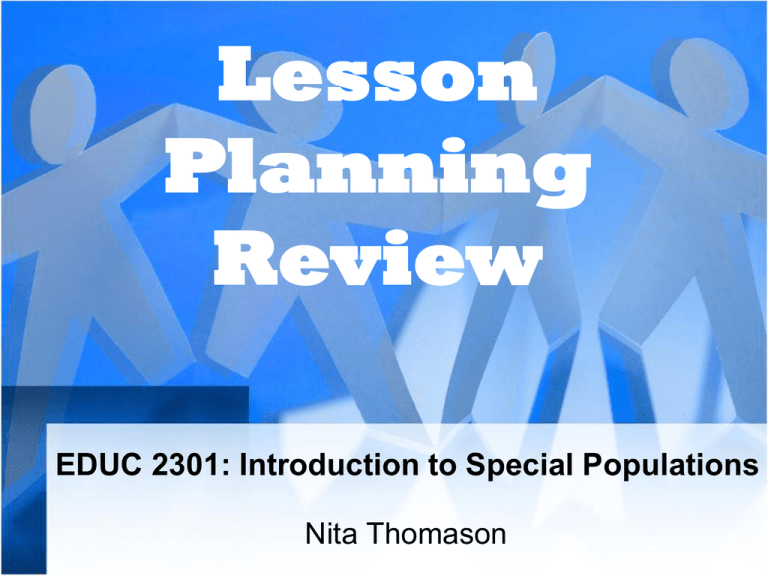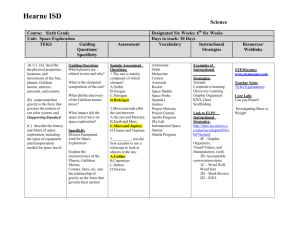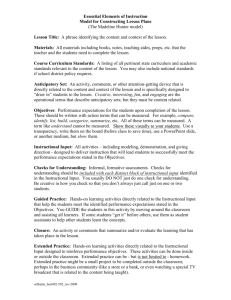Six Principles of Special Education
advertisement

Lesson Planning Review EDUC 2301: Introduction to Special Populations Nita Thomason • A lesson is the smallest individual piece of a concept, theme, or topic to be taught • A lesson should only include one element to avoid confusion or overload • Once students have mastered a lesson, the teacher can move on to the next piece • A lesson is NOT necessarily what can be covered in 45 minutes or bell-to-bell • Individual lessons make up a unit 2 • Adding fractions (NOT fractions) • Mimicry (NOT evolution) • Comma placement (NOT punctuation) • Battle of the Alamo (NOT Texas Indep.) • Vowels (NOT the alphabet) 3 • Various models for lesson design exist • Most common is “The Hunter Model” • More that just the grid-paper found in teacher plan books • Some schools have a specific format or form to use • First-Class Teacher p37 is basic 4 • • • • Anticipatory Set (Focus) Purpose Objective (& TEKS) Instructional Strategies Instructional Input Modeling Checking for Understanding Guided Practice Independent Practice • Closure • Assessment 5 • Anticipatory Set (Focus) A short activity or prompt that focuses the students’ attention before the actual lesson begins that is related to the lesson topic Examples: A song, a brain-teaser, overhead problems, etc. 6 • Purpose The “why” for the lesson. Why do students need to learn the content of the lesson. This is where you relate the lesson content to the students’ interests or prior knowledge. 7 • Objective • The “what” for the lesson. What is(are) the expectation(s) for the student. What will they learn or be able to do as a result of the lesson? • Daily/Lesson objectives should align with your long-range goals and district curriculum and the TEKS • Example: The student will be able to correctly identify at least 45 of the 50 U.S. State 8 Capitals on the unit exam. • TEKS (Objective) In Texas, you must list the TEKS addressed in the lesson alongside the objective(s). If you can’t find a corresponding TEKS for your objective, then DON’T teach it. Cite your TEKS as below: 6th Grade Mathematics: 111.22(b)(9)(B) – “Find the probability of a simple event and it’s compliment and describe the relationship between the two.” 9 • Parts of a Good Objective Conditions – under which the behavior is to be performed Behavioral Verb – action word that connotes an observable student behavior Criteria – specifies how well the student must perform the behavior 10 • Instructional Strategies Specific methods by which the teacher will get the objectives of the lesson across to the student. Almost every strategy will fall into one of several broad categories Not all types of strategies will necessarily be used in each lesson. 11 • Instructional Strategies Instructional Input (ii) Any strategy where the teacher directly imparts key knowledge to students Examples: Lectures, hand-outs, instructions, filmstrips, etc. 12 • Instructional Strategies Modeling (m) Any strategy where the teacher shows in graphic form or physically demonstrates what is expected of students 13 • Instructional Strategies – Checking for Understanding (cu) Any strategy that allows the teacher to informally determine if students have “got it yet” Examples: Question & Answer, Pop Quiz, Hovering, etc. 14 • Instructional Strategies – Guided Practice (gp) Any strategy where the teacher leads the students through the steps necessary to perform the skill (Hear-See-Do) 15 • Instructional Strategies – Independent Practice (ip) Any activity where the teacher releases students to practice a skill on their own (can be homework, but not necessarily) 16 • Closure The closing of the lesson where the teacher reviews what is learned, answers questions, fills in blanks, and ensures the students are finished with the learning process for the lesson. 17 • Assessment An activity where the teacher formally determines that students learned the knowledge or skills outlined in the lesson objective(s). Lesson assessments should directly measure the objectives (TEKS). Examples: Test or exam, project, term paper, presentation, etc. 18 • Plan the Lesson (What will we do?) • Teach the Lesson (Do it) • Evaluate the Lesson (What did we do?) • Repeat (Same lesson or new one) 19 Bloom’s Taxonomy (handout) • • • • • Creating Evaluating Analyzing Applying Understanding Remembering Learning Styles • Auditory – Identify sounds related to an experience – Learn by hearing and listening • Visual – Have a sharp, clear picture of an experience – Learn by seeing and looking • Kinesthetic/tactile – Learn by touching and doing – Develop a strong feeling toward an experience • Class Grade • Learning objectives (from TEKS) • Directions on how to do the activities • Materials required, copies of handouts and items referenced in lesson • Questions from Bloom’s Taxonomy • Adaptations for each of the 4 areas • Areas of development/learning styles • Overview -summary, considerations, challenges • References 22 • Work in Groups of up to 5 students. • Construct a set of unit plans according to the Curriculum Project (each student will provide lesson for one of the content areas listed in instruction b) • The remainder of class tonight is work time • Have rough ideas ready to share tomorrow during your group’s appointment time • Presentation of Unit is Sunday, Oct 16 • Written lesson plans are due Oct 16 23 24






